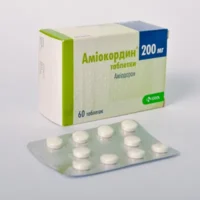Description
Eplepres (Eplerenone) Coated Tablets 25 mg. №30
Ingredients
Each coated tablet contains 25 mg of eplerenone.
Mechanism of Action
Eplepres (eplerenone) is a selective aldosterone blocker, which acts by inhibiting the effects of aldosterone, thereby reducing sodium and water retention. This mechanism helps in lowering blood pressure and improving heart function.
Pharmacological Properties
Eplepres exhibits its pharmacological effects by selectively blocking aldosterone receptors, leading to decreased sodium reabsorption and potassium excretion in the kidneys. This results in diuresis and natriuresis, contributing to its antihypertensive and anti-heart failure properties.
Indications for Use
Eplepres is indicated for the treatment of hypertension and heart failure in patients.
Contraindications
Do not use Eplepres if you are allergic to eplerenone or if you have hyperkalemia. It is important to consult with a healthcare provider before starting Eplepres to ensure it is safe and appropriate for your condition.
Side Effects
Common side effects of Eplepres may include hyperkalemia, dizziness, fatigue, and gastrointestinal disturbances. It is essential to report any adverse reactions to your healthcare provider.
Usage Instructions
The recommended dosage of Eplepres is one 25 mg tablet to be taken orally once daily. It is advised to swallow the tablet whole with a glass of water. Follow the instructions provided by your healthcare provider for optimal results.
Benefits Compared to Analogues
Eplepres has demonstrated similar efficacy to other aldosterone antagonists in managing hypertension and heart failure, with a more favorable side effect profile. This makes Eplepres a preferred choice for patients requiring aldosterone blockade therapy.
Suitable Patient Groups
Eplepres can be used in various patient groups including adults, elderly individuals, and specific pediatric populations under the supervision of a healthcare professional. Dosing adjustments may be necessary based on individual patient characteristics.
Storage and Shelf Life
Store Eplepres in a cool, dry place away from direct sunlight and moisture. Keep the tablets in their original packaging to protect them from environmental factors. Check the expiration date on the packaging and do not use expired medication.
Packaging Description
Eplepres is available in blister packs containing 30 coated tablets of 25 mg strength each. The packaging is designed to maintain the integrity of the tablets and provide necessary information such as dosage instructions and expiry date.
Clinical Evidence and Proven Effectiveness
Eplepres (eplerenone) has been extensively studied in clinical trials, demonstrating its efficacy in reducing blood pressure and improving outcomes in patients with heart failure. Clinical studies have shown that eplerenone can decrease the risk of cardiovascular events and mortality in specific patient populations.





